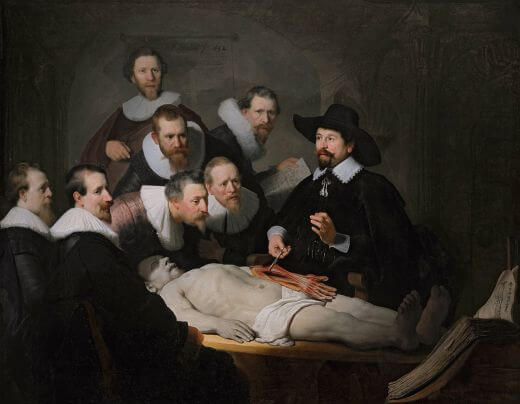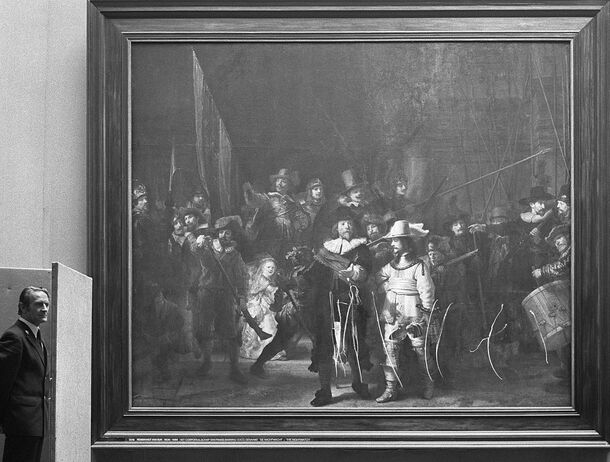|
Where? The Nachtwachtzaal in the Eregallerij on the second floor of the Rijksmuseum
When? 1642 Commissioned by? The Guild of the Sharp Shooters under the command of Captain Frans Banning Cocq What do you see? The Amsterdam Guild of the Sharp Shooters which consists of eighteen people. The painting is full of action and movement. In the center, you can see Captain Frans Banning Cocq (the man with the black hat) and his lieutenant Ruytenburch (dressed in white) stepping into the light. The captain is dressed in an elegant black outfit with a red sash. He holds a cane and a glove in his right hand and stretches his left arm forward to indicate that the guild members should start marching. The lieutenant indicates with the lance in his left hand the direction in which they should march. On the right, the drummer confirms that the guild should start marching by hitting the drum. The other men are grabbing their weapons, which include muskets, lances, and pikes. Behind the young girl to the left of the captain is the flag carrier. On the complete left of the painting is the sergeant who is carrying a, so-called, halberd. The man in red is filling his musket with gunpowder. In between the captain and the lieutenant is a man firing his weapon (you can just see the smoke to the left of the hat of the lieutenant).
Over the years, the paint in this work became darker, and that is the reason that in the 18th century the painting was called The Night Watch. However, there is no clear evidence that this scene is set in the night.
This is the largest painting by Rembrandt. It cost the guild at least 1600 guilders and each member contributed their share of money to pay Rembrandt. Not all members of the guild were happy with the final painting. The captain and his lieutenant were obviously happy with their prominent position, but the other members were not as happy as they were shown in the dark. In 1715, the painting was moved from its original location, and pieces from each side of the painting were cut off, whereby the painting lost about 20% of its original size. A copy of the Night Watch by Gerrit Lundens provides an indication of the missing pieces.
In his personal life, Rembrandt suffered a lot of setbacks. For example, around the time that this painting was finished, the wife of Rembrandt died. However, this did not affect his productivity as in the following years he seemed more productive than ever. He also lost three children shortly after birth.
Rembrandt was able to create a wide range of different paintings, including genre paintings, biblical paintings, mythological paintings, landscapes, and even animal paintings. Some other well-known works by Rembrandt include Saul and David and The Anatomy Lesson of Dr. Nicolaes Tulp, which are both in the Mauritshuis in The Hague.
Fun fact: The painting has been damaged on several occasions over time.
Interested in a copy for yourself? Poster or canvas (Amazon links)
CC BY-SA 3.0 NL Nationaal Archief
Written by Eelco Kappe
References:
1 Comment
|
Categories
All
|
- Home
- Blog
-
Museums
- Alte Pinakothek
- Art Institute of Chicago
- Baltimore Museum of Art
- Barber Institute of Fine Arts
- Bargello
- Barnes Foundation
- British Museum
- Church of Sant’Anastasia
- Cleveland Museum of Art
- Courtauld Institute of Art
- Detroit Institute of Arts
- Frans Hals Museum
- Galleria Borghese
- Gallerie dell'Accademia
- Getty Museum
- Guggenheim
- Hermitage Museum
- Kunsthistorisches Museum
- Kunstmuseum Basel
- Legion of Honor Museum
- Louvre
- Mauritshuis
- Metropolitan Museum of Art
- Musee d’Orsay
- Museum of Fine Arts in Boston
- Museum of Modern Art
- National Gallery in London
- National Gallery of Art
- National Museum in Poznań
- Norton Simon Museum
- Ny Carlsberg Glyptotek
- Palace of Versailles
- Palazzo Pitti
- Palazzo Vecchio
- Petit Palais
- Philadelphia Museum of Art
- Prado
- Pushkin Museum
- Ravenna Art Museum
- Rijksmuseum
- San Diego Museum of Art
- Santa Maria delle Grazie
- St. Peter's Basilica
- Städel Museum
- Statens Museum for Kunst
- Tate Britain
- Tate Modern
- Timken Museum of Art
- Uffizi
- Vatican Museums
- Wallace Collection
-
Artists
- Altdorfer
- Anguissola
- Berlin Painter
- Bosch
- Botticelli
- Boucher
- Bronzino
- Bruegel the Elder
- Brunelleschi
- Cabanel
- Caillebotte
- Canova
- Caravaggio
- Carpeaux
- Cezanne
- Cimabue
- David
- Degas
- Delacroix
- De Maria
- Donatello
- El Greco
- Fontana
- Fra Angelico
- Fragonard
- Gauguin
- Gentileschi
- Gericault
- Gonzalez-Torres
- Goya
- Hals
- Hogarth
- Hokusai
- Ingres
- Leonardo da Vinci
- Lippi, Filippo
- Longhi, Barbara
- Lorrain
- Makovsky
- Manet
- Massys
- Matisse
- Merian
- Michelangelo
- Mochi
- Modigliani
- Monet
- Panini
- Parmigianino
- Perugino
- Picasso
- Pisanello
- Raphael
- Rembrandt
- Renoir
- Reynolds
- Rivera
- Rodin
- Rubens
- Scultori
- Seurat
- Steen
- Tintoretto
- Titian
- Toulouse-Lautrec
- Turner
- Uccello
- Van der Weyden
- Van Dyck
- Van Eyck
- Van Gogh
- Van Hemessen
- Vasari
- Velazquez
- Vermeer
- Veronese
- Vigée Le Brun
-
Locations
- Books
- About Us







